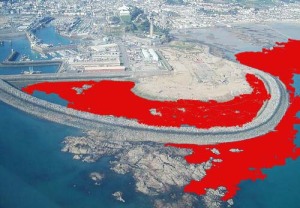
South Coast of Jersey with water flow from La Collette highlighted
The state of our coast line has a considerable ongoing problem with human pollution in the form of the increasing rubbish and sewage that we are producing, this in a week that the States as part of their strategy suggest growing the local population by several hundred year on year.
The Marine Conservation Society report in their “Beachwatch” 2008 that our coast has the highest level of litter recorded. One only has to walk along the tide line in Jersey to see a variety of human waste from carrier bags, plastic cups, and fishing waste to name a few.
Escherichia coli (E.-coli) is never far from the news and last year the public were warned not to eat wild shellfish around the La Rocque area within the Ramsar site. Over the winter reports have shown a deteriorating water quality around La Rocque and now the oysters produced in the area have been downgraded to a “B” category and the public are told not to eat wild shellfish not only because of the threat of E.-coli but also Norovirus.
Our concerns raised last year regarding the incinerator continue with more news of toxic ash pollution problems at the Waterfront and La Collette which are highlighted in an article “Jersey in Peril” and by a recent letter by Peter Double to the Jersey Evening Post titled “Environmental time bomb”
And as if living around the Waterfront was not bad enough we should also take on board the concern on shipping pollution quoted below from the United States especially as the Jersey States backed off raising duty on marine fuel last year,
“Unlike most diesel-powered vehicles, these ships have largely escaped regulation, partly because most are registered in other countries. As a result, large freighters often burn thick, syrupy oil filled with sulfur, a major contributor to toxic diesel soot. The fuel in these ships averages 27,000 parts per million (ppm) of sulfur, according to the U.S. Environmental Protection Agency (EPA). By comparison, diesel trucks must use fuel with only 15 ppm.
Due in part to this dirty fuel, neighborhoods around ports had the most toxic air in Washington state, according to a 2006 Seattle Times analysis.” By Blogfish
An the “Times” reports:
“Britain’s west coast is likely to be so badly affected by shipping pollution that average life expectancy for people living in or near coastal towns could be reduced by 20-30 months from 2020.”
Back in Jersey we have the reassurance on the matter as part of the Strategic Plan with the following asked of the Chief Minister:
Question: Can the Ministers reassure the public that local seafood for example Bass, Lobster, Crab, and Ormers are tested for toxins and are safe for human consumption, and how often such testing is undertaken?
Answer:
“Farmed shellfish is regularly tested but there is no routine testing for wild fish.”
“We have no reason to believe that there is a problem but we are of course vigilant in this area. We are confident that our waters are very clean.”
~~~~~
As a signatory to the OSPAR convention Jersey authorities should be aware of the following statement from their web site and acting upon it:
“By virtue of the precautionary principle, preventive measures are to be taken when there are reasonable grounds for concern that human activities may bring about hazards to human health, harm living resources and marine ecosystems, damage amenities or interfere with other legitimate uses of the sea, even when there is no conclusive evidence of a causal relationship. A lack of full scientific evidence must not postpone action to protect the marine environment. The principle anticipates that delaying action would in the longer term prove more costly to society and nature and would compromise the needs of future generations.”
For fish lovers bear in mind that the U.K. Committee on Toxicity outlined in a paper the following:
“The concentrations of dioxin-like compounds in some species of non-oily fish (sea bass, sea bream, halibut, turbot, dogfish and crab) are similar to those commonly found in some oily fish. Frequent consumption of these species of fish in addition to the recommended amounts of oily fish could result in exceedance of the intake guidelines for dioxin-like compounds.”
Leave a comment